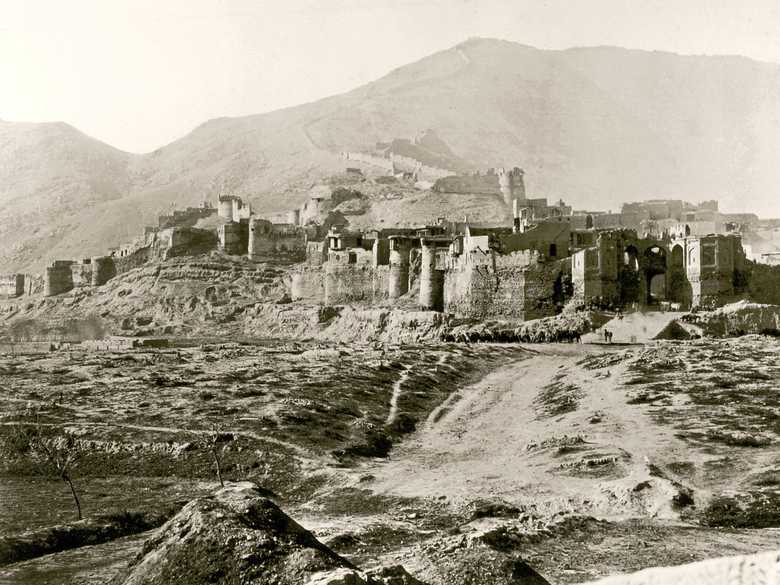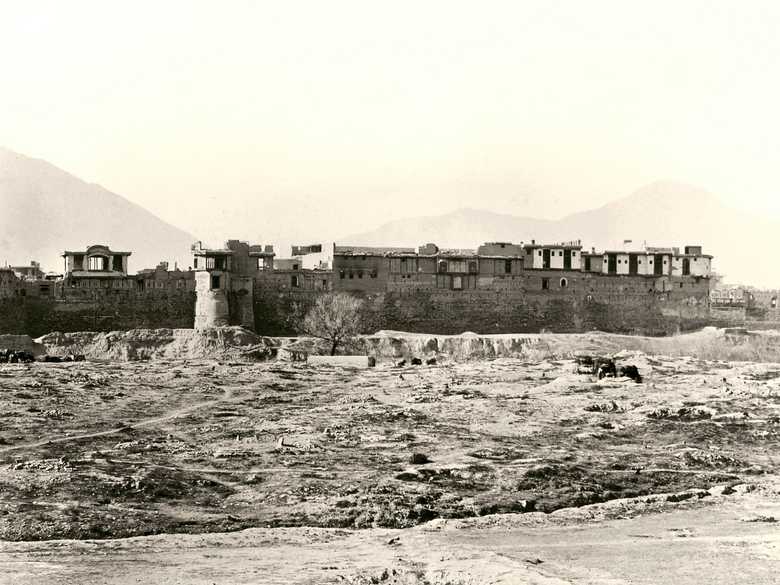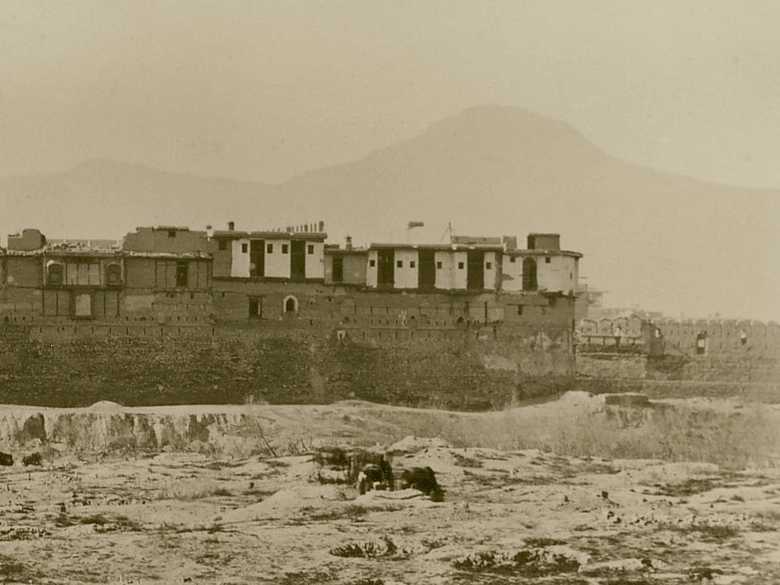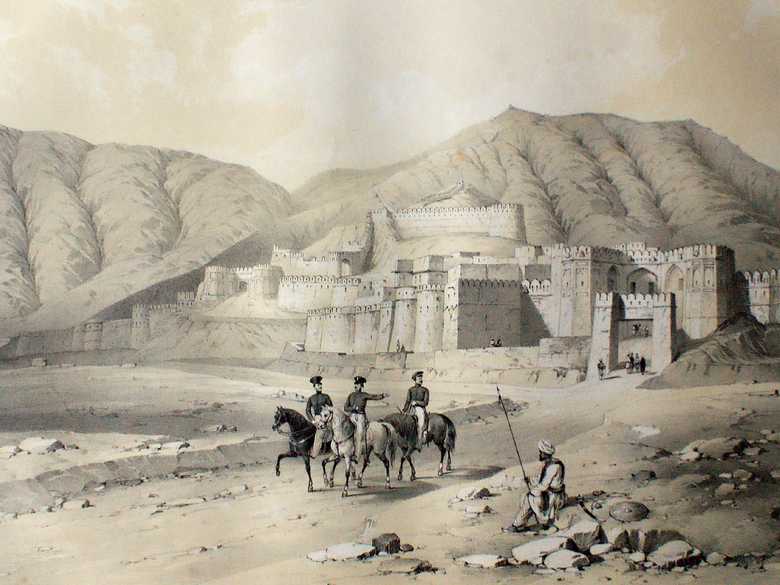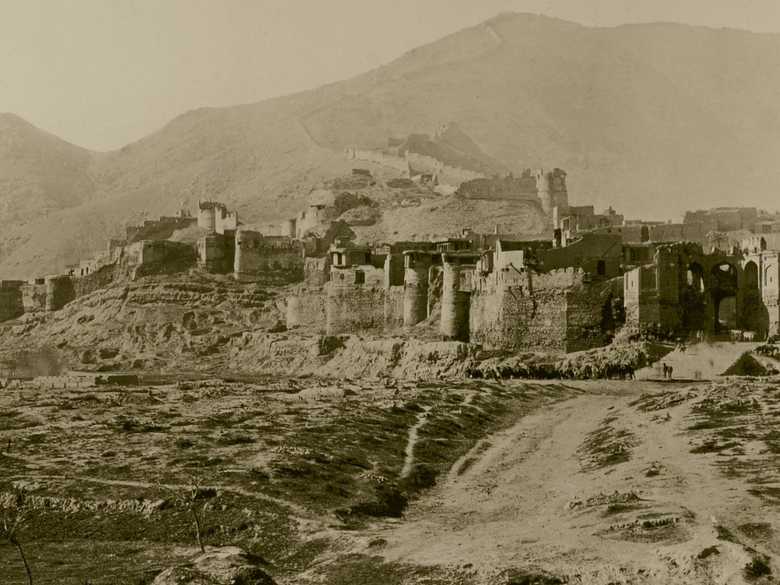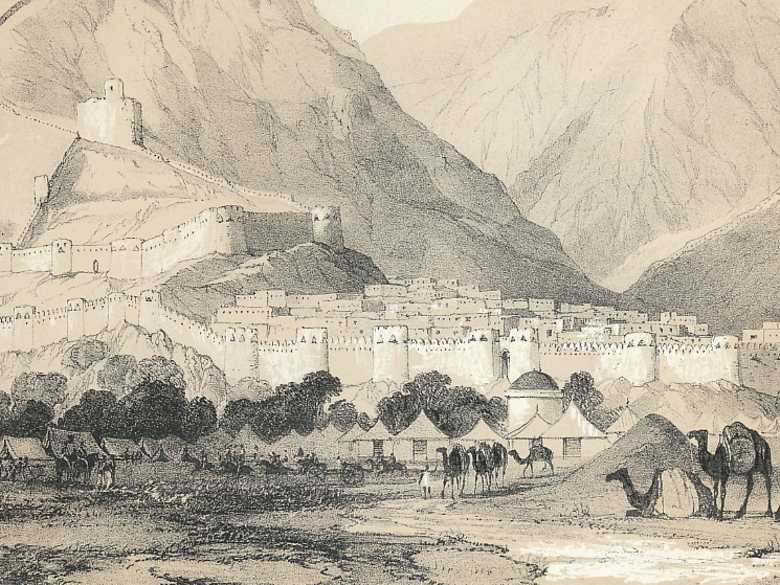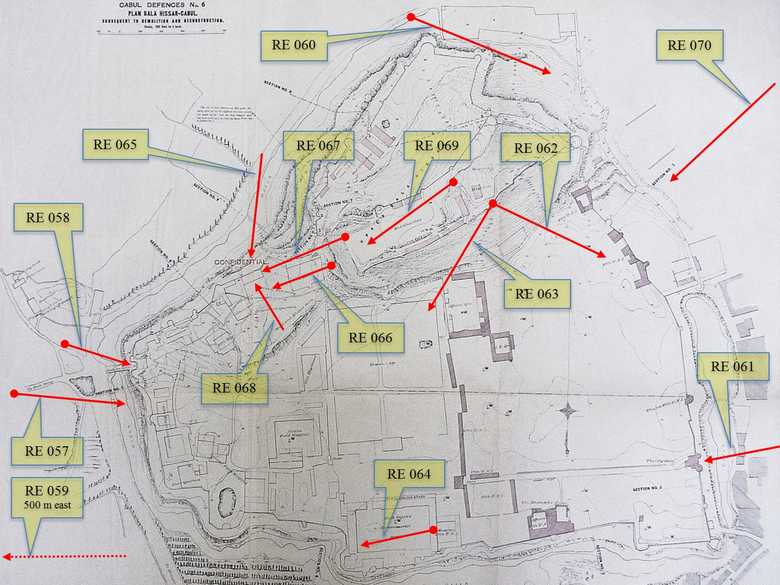RE 057 — Bala Hissar and Palace
Panorama of the south-eastern front of the Bala Hissar fortifications, seen from a hillock near the Ziyarat-e Shah Shahid (see RE 059), opposite the main gate. According to Afghan tradition [S.Q. Reshtia] this gate was called Peshawar Gate or Shah Shahid Gate; the Lahore Gate was situated at the eastern end of the Char Chatta Bazar of the city. In the background the fortifications run up to the Bala Borj (upper tower) and the wall, on the crest of the mountain Sher Darwaza. The white buildings o...
Detail of a lithograph based on a very accurate sketch by Lt. Sturt, in R. H. Sale: “The Defence of Jellalabad”, 1845.
Detail of a lithograph based on a sketch by Keith A. Jackson, published in his “Views in Affghaunistaun”, 1841.
Panorama of the south-eastern front of the Bala Hissar fortifications, seen from a hillock near the Ziyarat-e Shah Shahid (see RE 059), opposite the main gate. According to Afghan tradition [S.Q. Reshtia] this gate was called Peshawar Gate or Shah Shahid Gate; the Lahore Gate was situated at the eastern end of the Char Chatta Bazar of the city. In the background the fortifications run up to the Bala Borj (upper tower) and the wall, on the crest of the mountain Sher Darwaza. The white buildings on the right corner used to be the prison and residence of Prince Mhd Yaqub, son of Amir Sher Ali.
[Album:] Bala Hisar Kabul, from Peshawar side, Shahr Darwaza hill beyond // Showing the entrance from the Bhutkhak road, on the East by the Lahore Gate. The corner buildings are Yakoob Khan's residence and former place of confinement.
[Album, on label from S&M list:] 2-1/2 Bala Hissar and Palace.
- Original:
Chatham: Box No.: E 4, Album No.: 4/4, Page No.: 32 - Collection Cabul Defences, Photo-No. 10, the same panorama: “Bala Hissar. / Showing the entrance from the Bhutkhak road, on the East by the Lahore Gate.”
- Thackeray, E.T. (1881): Views of Kabul and Environs, plates 14 and 30: (separate) identical photographs, “The Bala Hissar and Palace.”
- The Second Afghan War 1878-80: Abridged Official Account (1908), f.p. 238: identical photograph as folding panorama, “The Bala Hissar and Palace, 1879.”
- Collection John Burke, JB-178 and 179 is a similar panorama, but taken from further left.
- N.H. Dupree (1977): An Historical Guide to Afghanistan, pp. 82-83: "Kabul's Bala Hissar, rising 150 feet above the plain, witnessed most of the exciting events of Afghanistan's history up until the spring of 1880. Babur, founder of the Moghul Empire of India, lived here early in the 16th century. He loved it well, did much to embellish it, and wrote poetry extolling its commanding view. Succeeding kings alternately ruled from it or languished in its dungeons. Then, on that fateful day in September 1879, a British Representative, Sir Louis Cavagnari, and his escort, were cut down in one of its palaces on the southern side.
- W. Ball (1981): Archaeological Gazetteer of Afghanistan, pp. 136-137: Kabul.
- L.W. Adamec (1985): Kabul and southeast Afghanistan, pp. 324-338: Kabul City, p. 324: "The old residence of the Amirs of Kabul used to be in the Bala Hisar, but the Amir moves about from one to another of the various country residences that he has built on favourable spots in the neighbourhood of the city."
- Schinasi, M. (2008): Kaboul 1773-1948, pp. 42-44: La citadelle (bala hesar).
- Woodburn, C.W. (2009): The Bala Hissar of Kabul. Revealing a fortress-palace in Afghanistan, p. 25, fig. 31: “The south-east corner of the lower Bala Hissar in 1879, with the main gate on the right. The walls had become fairly degraded by this time and parts could not be used as a firing platform as buildings had been constructed on them.”; p. 26, fig. 32: “The north-east corner of the lower Bala Hissar in 1879, showing Amir Sher Ali’s palace.”
Image No.
RE 057
Collection
Royal Engineers Museum, Library and Archive 1878-1880 1878-1880
Series
RE 057-099, Kabul Photographs
Format
Two albumen paper with gold toning, 210/280 mm, mounted on cardboard
Quality
good, background faded
Place, date
Kabul, 1879
Descriptors
Latitude / Longitude34.508689 / 69.198501
Google Earth34°30'32" N / 69°11'52" E / 1800 m
Google Mapshttps://maps.google.com
Zoom Earthhttps://zoom.earth
Survey of India MapSheet 38 (1917), Kabul: Kabul, Bala Hissar, 2B 26
833 KB |

153 KB |

You know more about this picture?


![Panorama of the south-eastern front of the Bala Hissar fortifications, seen from a hillock near the Ziyarat-e Shah Shahid (see RE 059), opposite the main gate. According to Afghan tradition [S.Q. Reshtia] this gate was called Peshawar Gate or Shah Shahid Gate; the Lahore Gate was situated at the eastern end of the Char Chatta Bazar of the city. In the background the fortifications run up to the Bala Borj (upper tower) and the wall, on the crest of the mountain Sher Darwaza. The white buildings on the right corner used to be the prison and residence of Prince Mhd Yaqub, son of Amir Sher Ali. Panorama of the south-eastern front of the Bala Hissar fortifications, seen from a hillock near the Ziyarat-e Shah Shahid (see RE 059), opposite the main gate. According to Afghan tradition [S.Q. Reshtia] this gate was called Peshawar Gate or Shah Shahid Gate; the Lahore Gate was situated at the eastern end of the Char Chatta Bazar of the city. In the background the fortifications run up to the Bala Borj (upper tower) and the wall, on the crest of the mountain Sher Darwaza. The white buildings on the right corner used to be the prison and residence of Prince Mhd Yaqub, son of Amir Sher Ali.](/fileadmin/_processed_/2/2/csm_RE_057-1_0400a0a84f.jpg)
